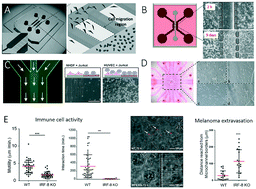Our official English website, www.x-mol.net, welcomes your
feedback! (Note: you will need to create a separate account there.)
Recent advances in microfluidic technologies for cell-to-cell interaction studies
Lab on a Chip ( IF 6.1 ) Pub Date : 2017-10-31 00:00:00 , DOI: 10.1039/c7lc00815e Mario Rothbauer 1, 2, 3, 4, 5 , Helene Zirath 1, 2, 3, 4, 5 , Peter Ertl 1, 2, 3, 4, 5
Lab on a Chip ( IF 6.1 ) Pub Date : 2017-10-31 00:00:00 , DOI: 10.1039/c7lc00815e Mario Rothbauer 1, 2, 3, 4, 5 , Helene Zirath 1, 2, 3, 4, 5 , Peter Ertl 1, 2, 3, 4, 5
Affiliation

|
Microfluidic cell cultures are ideally positioned to become the next generation of in vitro diagnostic tools for biomedical research, where key biological processes such as cell signalling and dynamic cell-to-cell interactions can be reliably analysed under reproducible physiological cell culture conditions. In the last decade, a large number of microfluidic cell analysis systems have been developed for a variety of applications including drug target optimization, drug screening and toxicological testing. More recently, advanced in vitro microfluidic cell culture systems have emerged that are capable of replicating the complex three-dimensional architectures of tissues and organs and thus represent valid biological models for investigating the mechanism and function of human tissue structures, as well as studying the onset and progression of diseases such as cancer. In this review, we present the most important developments in single-cell, 2D and 3D microfluidic cell culture systems for studying cell-to-cell interactions published over the last 6 years, with a focus on cancer research and immunotherapy, vascular models and neuroscience. In addition, the current technological development of microdevices with more advanced physiological cell microenvironments that integrate multiple organ models, namely, the so-called body-, human- and multi-organ-on-a-chip, is reviewed.
中文翻译:

微流体技术在细胞间相互作用研究中的最新进展
微流体细胞培养物的理想位置是成为下一代生物医学研究的体外诊断工具,在这种方法中,可以在可重现的生理细胞培养条件下可靠地分析关键的生物过程,例如细胞信号转导和动态的细胞间相互作用。在过去的十年中,已经开发出了用于各种应用的大量微流细胞分析系统,包括药物靶标优化,药物筛选和毒理学测试。最近,先进的体外微流控细胞培养系统已经出现,能够复制组织和器官的复杂三维结构,从而代表了有效的生物学模型,可用于研究人体组织结构的机制和功能,以及研究疾病的发生和发展,例如癌症。在这篇综述中,我们介绍了过去6年中发布的用于研究细胞间相互作用的单细胞,2D和3D微流体细胞培养系统的最重要发展,重点是癌症研究和免疫疗法,血管模型和神经科学。另外,综述了具有更先进的生理细胞微环境的微设备的当前技术发展,该设备集成了多个器官模型,即所谓的人体,人体和多器官芯片。
更新日期:2017-11-16
中文翻译:

微流体技术在细胞间相互作用研究中的最新进展
微流体细胞培养物的理想位置是成为下一代生物医学研究的体外诊断工具,在这种方法中,可以在可重现的生理细胞培养条件下可靠地分析关键的生物过程,例如细胞信号转导和动态的细胞间相互作用。在过去的十年中,已经开发出了用于各种应用的大量微流细胞分析系统,包括药物靶标优化,药物筛选和毒理学测试。最近,先进的体外微流控细胞培养系统已经出现,能够复制组织和器官的复杂三维结构,从而代表了有效的生物学模型,可用于研究人体组织结构的机制和功能,以及研究疾病的发生和发展,例如癌症。在这篇综述中,我们介绍了过去6年中发布的用于研究细胞间相互作用的单细胞,2D和3D微流体细胞培养系统的最重要发展,重点是癌症研究和免疫疗法,血管模型和神经科学。另外,综述了具有更先进的生理细胞微环境的微设备的当前技术发展,该设备集成了多个器官模型,即所谓的人体,人体和多器官芯片。











































 京公网安备 11010802027423号
京公网安备 11010802027423号